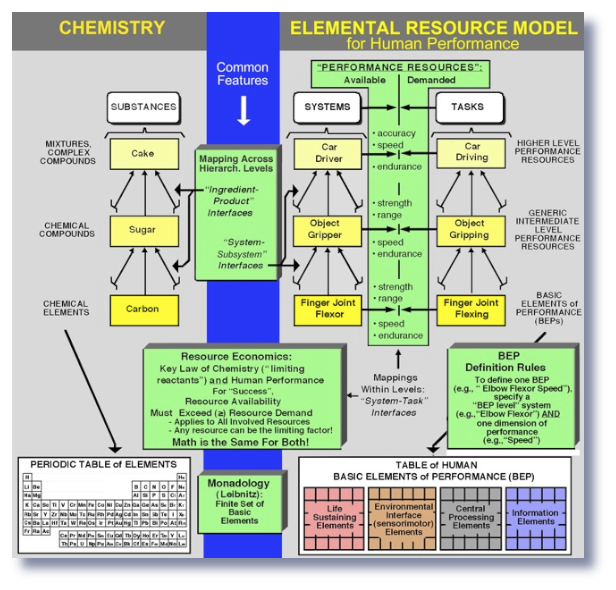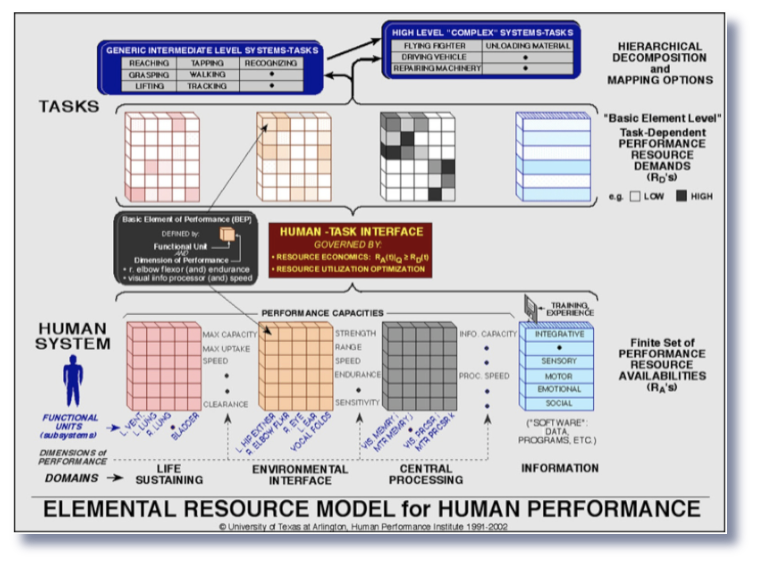The Elemental Resource Model (ERM)
HPM has adopted a unique conceptual framework with two main components:
1. General Systems Performance Theory (GSPT), and
2. the Elemental Resource Model (ERM) for human performance
Because of this conceptual framework, it is possible to recognize and use the human system and its "design" as the common denominators across all situations (diseases, injuries, etc.) and human endeavors (athletics, specialized job training, etc.). This, in turn, enables the use of a generalizable and application independent approach to measurement and assessment of human performance capacities. This provides internal consistencies, standardization, expandability with compatibility, and a basis for understanding measurement tools and the measurement-assessment process that has not previously been available. GSPT and the ERM serves as the basis for defining and categorizing all measurements acquired with BEP modules.
The concept of "performance" pervades nearly all aspects of life, especially decision-making processes that involve human and artificial systems. Yet, it has not well understood theoretically and techniques for its modeling and measurement in all fields have been ad hoc at best. Although a considerable body of material known as general systems theory exists, the concept of performance has not been incorporated in it nor has performance been addressed in a general sense elsewhere. Most knowledge that does exist about performance and its quantitative treatment has evolved within specific applications, where generalizations can easily be elusive. Performance is multi-faceted, pertaining to how well a given system executes an intended function and the various factors that contribute to this. It differs from "behavior" in that "the best of something" is implied.
General Systems Performance Theory (GSPT) was developed by Kondraske in 1987 in response to these observations. Its broad objectives are to: (1) provide a common conceptual basis for defining and measuring all aspects of any system's performance; (2) provide a common conceptual basis for the analysis of any task in a manner that facilitates system-task interface assessments and decision-making; and (3) identify cause-and-effect principles that explain what occurs when any given system is used to accomplish any given task. Some of the more striking features of GSPT include the consistent use of a resource construct to model all aspects of a system's performance (i.e., performance capacities) and the nonlinear, "threshold effect" associated with resource economics.
HPM has adopted a unique conceptual framework with two main components:
1. General Systems Performance Theory (GSPT), and
2. the Elemental Resource Model (ERM) for human performance
Because of this conceptual framework, it is possible to recognize and use the human system and its "design" as the common denominators across all situations (diseases, injuries, etc.) and human endeavors (athletics, specialized job training, etc.). This, in turn, enables the use of a generalizable and application independent approach to measurement and assessment of human performance capacities. This provides internal consistencies, standardization, expandability with compatibility, and a basis for understanding measurement tools and the measurement-assessment process that has not previously been available. GSPT and the ERM serves as the basis for defining and categorizing all measurements acquired with BEP modules.
The concept of "performance" pervades nearly all aspects of life, especially decision-making processes that involve human and artificial systems. Yet, it has not well understood theoretically and techniques for its modeling and measurement in all fields have been ad hoc at best. Although a considerable body of material known as general systems theory exists, the concept of performance has not been incorporated in it nor has performance been addressed in a general sense elsewhere. Most knowledge that does exist about performance and its quantitative treatment has evolved within specific applications, where generalizations can easily be elusive. Performance is multi-faceted, pertaining to how well a given system executes an intended function and the various factors that contribute to this. It differs from "behavior" in that "the best of something" is implied.
General Systems Performance Theory (GSPT) was developed by Kondraske in 1987 in response to these observations. Its broad objectives are to: (1) provide a common conceptual basis for defining and measuring all aspects of any system's performance; (2) provide a common conceptual basis for the analysis of any task in a manner that facilitates system-task interface assessments and decision-making; and (3) identify cause-and-effect principles that explain what occurs when any given system is used to accomplish any given task. Some of the more striking features of GSPT include the consistent use of a resource construct to model all aspects of a system's performance (i.e., performance capacities) and the nonlinear, "threshold effect" associated with resource economics.

The ERM contains multiple hierarchical levels at which "systems" are identified. Performance resources at the "basic element level" are finite in number, as dictated by finite sets of human subsystems and their respective dimensions of performance. At higher levels, new "systems" (collectively resulting in a near-infinite number of higher level elements) are readily created by reconfiguration of subsystems at the basic element level. Performance theory concepts are applied in a consistent manner at all levels.
The ERM serves both short- and long-range purposes. In the short-term, it helps identify performance parameters that reflect a system’s performance. Also, by using the resource construct it ensures that a consistent way is used to measure performance of any and all human subsystems. Over the longer-term, the groundwork is put in place for rigorous, objective analyses of the interface of human systems to tasks.

The threshold nature of the mathematics that describes this interface is particularly noteworthy.
The lower portion of the figure, representing the human system, reflects a type of "periodic table" for the the "basic elements of performance" (BEPs) of the human system.
Looking Toward the Human: The entire human (lower part of figure) is modeled as a pool of elemental performance resources grouped into four different domains: (1) life sustaining, (2) environmental interface (containing sensory and sensorimotor subsystems), (3) central processing, and (4) information. Within the first three domains, physical subsystems referred to as functional units are identified (see horizontal aspect of grids) through application of fairly rigorous criteria. GSPT is applied to each, yielding a set of dimensions of performance. A single Basic Element of Performance (BEP) is defined by specifying: (1) the basic functional unit and (2) one of its dimensions of performance. Resource availability (which is a capacity) is determined by isolating a given system along one or more of its dimensions of performance; i.e., this is the general objective of a performance test. Specific diseases, injuries or training endeavors either reduce or increase the amount of performance resources available to accomplish tasks. Thus, measurement of the amount of each resource available is rational, justified, and valuable.
The information domain is substantially different from the other three. Whereas the first three represent physical systems and their intangible performance resources, the information domain simply represents "information". Thus, memory functional units are located within the central processing domain, while the contents of memory (e.g., motor programs and associated reference information acquired through training or experience) are partitioned into the information domain. As illustrated, information is grouped but within each group there are many specific information sets. The overall approach permits even the most abstract items such as motivation and "gentleness" to be considered with the same framework as strength and speed.
Looking Toward the Task: The mid-portion of the above figure suggests the representation of any given task in terms of the unique set of demands imposed on the pool of BEPs and information resources; i.e., this is the elemental level of task representation. Shadings imply the representation of demands in terms of amount. The upper portion of the figure defines hierarchical mapping options.
The Human-Task Interface: Using GSPT, success in achieving the goals of a given task segment is governed by resource economic principles requiring that performance resource availability exceeds demand. In other words, all task demands, when translated to the individual subsystems involved, must fit within the envelopes that define performance resource availability. Adequacy associated with any one resource is a necessary, but not sufficient condition for success. In other words, the human system must have "enough" of each performance resource. Concepts and observations referred to as "compensation" or "redundancy" are explained in terms of resource utilization flexibility and optimization based on stress minimization, which includes the possibility of substituting one performance resource (of the same dimensionality) for another (i.e., resource substitution).
With HPM's measurement tools, it is possible to make performance measurements not only at the basic element level, but also for systems that represent combinations of these basic functional units, such as lifting systems, postural stabilizing systems, etc. The functions performed by these systems, termed generic intermediate level tasks, represent a "next higher level" in the hierarchy of the ERM.
The information domain is substantially different from the other three. Whereas the first three represent physical systems and their intangible performance resources, the information domain simply represents "information". Thus, memory functional units are located within the central processing domain, while the contents of memory (e.g., motor programs and associated reference information acquired through training or experience) are partitioned into the information domain. As illustrated, information is grouped but within each group there are many specific information sets. The overall approach permits even the most abstract items such as motivation and "gentleness" to be considered with the same framework as strength and speed.
Looking Toward the Task: The mid-portion of the above figure suggests the representation of any given task in terms of the unique set of demands imposed on the pool of BEPs and information resources; i.e., this is the elemental level of task representation. Shadings imply the representation of demands in terms of amount. The upper portion of the figure defines hierarchical mapping options.
The Human-Task Interface: Using GSPT, success in achieving the goals of a given task segment is governed by resource economic principles requiring that performance resource availability exceeds demand. In other words, all task demands, when translated to the individual subsystems involved, must fit within the envelopes that define performance resource availability. Adequacy associated with any one resource is a necessary, but not sufficient condition for success. In other words, the human system must have "enough" of each performance resource. Concepts and observations referred to as "compensation" or "redundancy" are explained in terms of resource utilization flexibility and optimization based on stress minimization, which includes the possibility of substituting one performance resource (of the same dimensionality) for another (i.e., resource substitution).
With HPM's measurement tools, it is possible to make performance measurements not only at the basic element level, but also for systems that represent combinations of these basic functional units, such as lifting systems, postural stabilizing systems, etc. The functions performed by these systems, termed generic intermediate level tasks, represent a "next higher level" in the hierarchy of the ERM.
▾
▾